November 18 - 24, 2018: Issue 384
John Forbes
“Not every legend is a myth, some are flesh and blood. Some legends walk among us, but they aren’t born, they’re built. Legends are made from iron and sweat, mind and muscle, blood and vision and victory. Legends are champions, they grow, they win, they conquer. There’s a legend behind every legacy, there’s a blueprint behind every legend.” - Arnold Schwarzenegger
Pittwater is one of those places where you can never be too sure who you're meeting and often you're coming face to face with someone who has quietly achieved and doesn't need a fanfare every time they enter a room. In fact, our area abounds with such individuals, people who have quietly gone about doing great things, and continue to do so, in a wide variety of areas from business to sports to the environment.
Not only have they excelled on world stages they also persevere in doing great things past those so-called 'pinnacle' moments and if you ask them what they're most happy about, it's more often marrying the woman of their dreams and raising great children with her. Outside of that, it's being part of a local club that also quietly goes about achieving great things, advancing everything for all and keeping it open to all with that old 'all are welcome, all belong' credo that goes back as far as time itself.
John Forbes has represented Australia in 3 Olympic Games in sailing catamarans (Barcelona 1992, Sydney 2000, Athens 2004). He was a Bronze Medallist in Barcelona, Silver Medallist in Sydney and placed 6th in Athens.
During his 18 years of intense international sailing regatta at an elite level he was 7 x World Champion, 4 x European Champion and 10 x Australian Champion.
He has been a member of Palm Beach Sailing Club for 30 years. Now 48 years old and sailing with 17 year old daughter Bronte (attending Queenwood School at Balmoral) he has re-entered the sailing scene to enjoy teaching his daughter the beautiful skill of sailing high speed catamarans and passing on his wealth of knowledge to all the teams whom he competes with.
In fact, family, and running the family business, are now his focus, with joy undiminished for getting out among those salty breezes - which is where it all began - with family, among salty breezes:
When and where were you born?
I was born in Sydney at Royal North Shore Hospital. I grew up in Mona Vale until I was 7. Then from 7 until I was 35 I lived at Collaroy Plateau and from then on we’ve been at Bayview.
My parents were originally from Kingsford and Drummoyne. They moved to Mona Vale when I was born. We’ve always been on the northern beaches and my parents are at Bayview now as well.
What changes have you seen here during those decades?
More traffic lights would be the main thing, to cope with all the extra people. There is certainly a lot more boats on Pittwater, the amount of moorings has certainly reduced the area to sail in, especially down the southern end of Pittwater. That’s why Palm Beach Sailing Club prefers to be up the northern end, as there are less moorings up there. Unfortunately probably not enough has changed in terms of infrastructure; we still have the same amount of lanes and the same Spit Bridge for access into the city.
What did you do for fun while growing up?
We really did two things; sailing and BMX bike riding around the streets and in backyards. We rode the bikes mainly when we were at Collaroy Plateau when there were still blocks of land up there that weren’t built on. This was in the late 1970’s when there was still a lot of bush up there, which is gone now of course.
We also did a lot of sailboarding which was something we’d do at Long Reef or on Narrabeen Lagoon. That was when sailboarding or windsurfing was at its peak. We were right into that.
How did you get into sailing – what was your first boat?
A Hobie Cat 11 that we sailed on Narrabeen Lagoon. Dad got me into this. My father, Bob Forbes, started Hobie sailing in the mid 1970’s and did a lot of major competitions, a lot of National and World Championships in the Hobie Cat. One of the biggest events he went in was in Hawaii. When he was over there he saw that there were bigger boats than the Hobie 16 and wanted to bring back the Hobie 18 to Australia. He said to Hobie Cat Australia, ‘can we bring in the Hobie 18 because that’s the next step and it’s a much bigger and better boat’. Hobie Cat Australia said no, they weren’t going to bring it in.
He went back to America about two years later and was going to buy 10 Hobie 18s’ and bring them in. When he got to America one of the top sailing teams over there said ‘don’t bring in the Hobie 18, there’s a new boat out called a Nacra and that is a slightly more high performance boat and you’d do better to take that back as not only will you not have a clash with Hobie Australia, you will be bringing back something better.’
So my dad brought back the first 10 Nacra catamarans and sold them, this was 1979 I think. He decided he wanted to sell boats. Shortly afterwards he spoke to Nacra and said we wanted to be the agent in Australia for these. As a result in the early 1980s’ we ended up building the Nacras in their entirety here for 8 or 9 years. The business was called ‘Windsports’, headquartered in Darley street in Mona Vale eventually and in Cromer and Warriewood during its infancy.
From that grew the Nacra sailing. We quickly progressed in sailing Nacras as kids. When I was 12 we went to America to compete in the Nacra North American sailing championships for the first time. I was sailing with my father and David Renouf, a fellow member at PBSC. David actually used to build the boats for us at that time, as did Mitch Booth. Around 10 years later we sold that business to the distributor from Brisbane.
Did your dad have any results in the competitions he entered?
Yes, dad was a very good sailor. He also sailed the Tornado Catamaran as well and he and another guy tried to compete at the 1984 Los Angeles Olympics. They didn’t end up going – Chris Cairns and Scott Anderson went and ended up winning the Bronze medal for Australia. Dad went to the Olympic test event in Los Angeles the year before the Games, as well as competing in many World Championships in the Tornado.
At that time it was a very competitive class, we had Chris Cairns, who won two World Championships and the Bronze medal. There was also Brian Lewis who had won six or seven National Championships, so there was some pretty tough competition for my father then. Dad was born in 1942 so he would have been in his 40s’ when he was competing in the Tornado.
Let’s talk about your ventures into Olympic games – you have been a 10 x Australian Champion, 4 x European Champion and 7 x World Champion; were these pre qualifying for the Olympics – how did it all begin?
I first got into the Tornado class sailing with Chris Cairns, he was looking for a new crew for the 1988 Olympics and was then a member of Palm Beach Sailing Club, or Pittwater Catamaran Club as well. So I signed on with him in 1987; I had a good Tornado catamaran at that time and he didn’t. We went to Europe and won the Kiel Week Regatta, one of the biggest regattas in Europe. A week later we came 2nd at the World Championship. I was 17 then and that was my first trip to Europe sailing – so you couldn’t get much better than that. As it turned out, the guy who beat us at that World Championship ended up being the Gold medallist in the Sydney 2000 and Athens 2004 Olympics. So we became competitors from that point on, from 1987 right through to 2004. His name is Roman Hagara.
The partnership with Chris didn’t last – I was still doing my HSC at the time and there were other pressures on both of us. It was still a very good learning curve for me and I was still at that stage, at 17; ‘do I Skipper, do I crew?’.
We tried out for the Seoul Olympics but only did one selection event before splitting.
After that I teamed up with Rod Waterhouse for the Tornado Nationals which we won with seven straight 1st places. That was my first of 10 Tornado Nationals wins. That first win was pretty special, mainly because we won every race, beating the guy who had competed at the Seoul Olympics amongst others. Rod is an excellent sailor, and we hadn’t done much together at that time, so to come away with those results was really good. We applied to get funding for the World Championship in Texas that year. Rod couldn’t go to the World Championship due to work commitments. I wanted to then go with someone else and the Sailing Federation said no, they don’t recognise crews, just Skippers at that time, and would only give the funding to a Skipper.
I jumped up and down and said ‘that’s not right, I’ve won the Nationals and had other good results previously with other people’ but they still said no, the policy was that the funding went to the Skipper. As a result they gave the funding to go to the World Championship to the 2nd place and 3rd place boats.
That was my first introduction to the Sailing Federation and pretty hard as an 18 year old in that they didn’t recognise the crew, at all, in anything. After six months of jumping up and down I just accepted that that was life and teamed up with Mitch Booth. We went to the World Championship off our own bat, with no funding from the Yachting Federation, and we won that World Championship – by 36 points.
We then came back to the Yachting Federation and said, ‘now we want the funding’ and they were then like ‘yeah, no worries’. That was a turning point as well as it did give the crews a lot of credibility from that point on because we put up a fairly strong argument that it is actually a team, not just one guy sitting at the back. That was a pretty important time – I was young, was looking for recognition, and to go and win that World Championship against those odds and by 36 points was quite incredible. This also paved the way, in one sense, for catamaran sailing as well; we’d been quite dominant with our results, ended up with a lot of exposure out of the whole matter and that in turn created a lot more interest in catamaran sailing in the public eye. It was also just at the commencement of advertising on the boats as well. Prior to that World Championship advertising hadn’t been allowed in sailing. That was the first year they relaxed the rules a little bit to allow advertising and attracting sponsorship and it had become a little more professional orientated as a result. We were fortunate in that we picked up a couple of good sponsors and that in turn placed sailing before the eyes of others as well.
So you went to the Barcelona Olympics with Mitch Booth?
Yes. With Mitch we won another World Championship in 1992 and then went to the Olympics, regrettably as the favourites. I’ve done that every time; gone in as the favourite and not got the gold medal – it’s like a hex.
Barcelona was sailed using the old courses, very long courses and three hour races, big long marathons. In Barcelona it just did not blow, only drifters. We were taking more than three hours to complete the course, although many races were abandoned because we just did not finish within the time limit. In one race we just went home at the commencement of the final leg of the race. People were saying ‘what are you doing?!’ to which we could reply ‘we’re not going to get up there – it’s going to take us 40 minutes to just get up to that mark and we only have 20 minutes left.’ We still had a really good result in those conditions, in those drifter type winds, it’s often really tough to get a good result for a whole week. We were happy with that and I went to my first Olympics at 22 and got a medal.
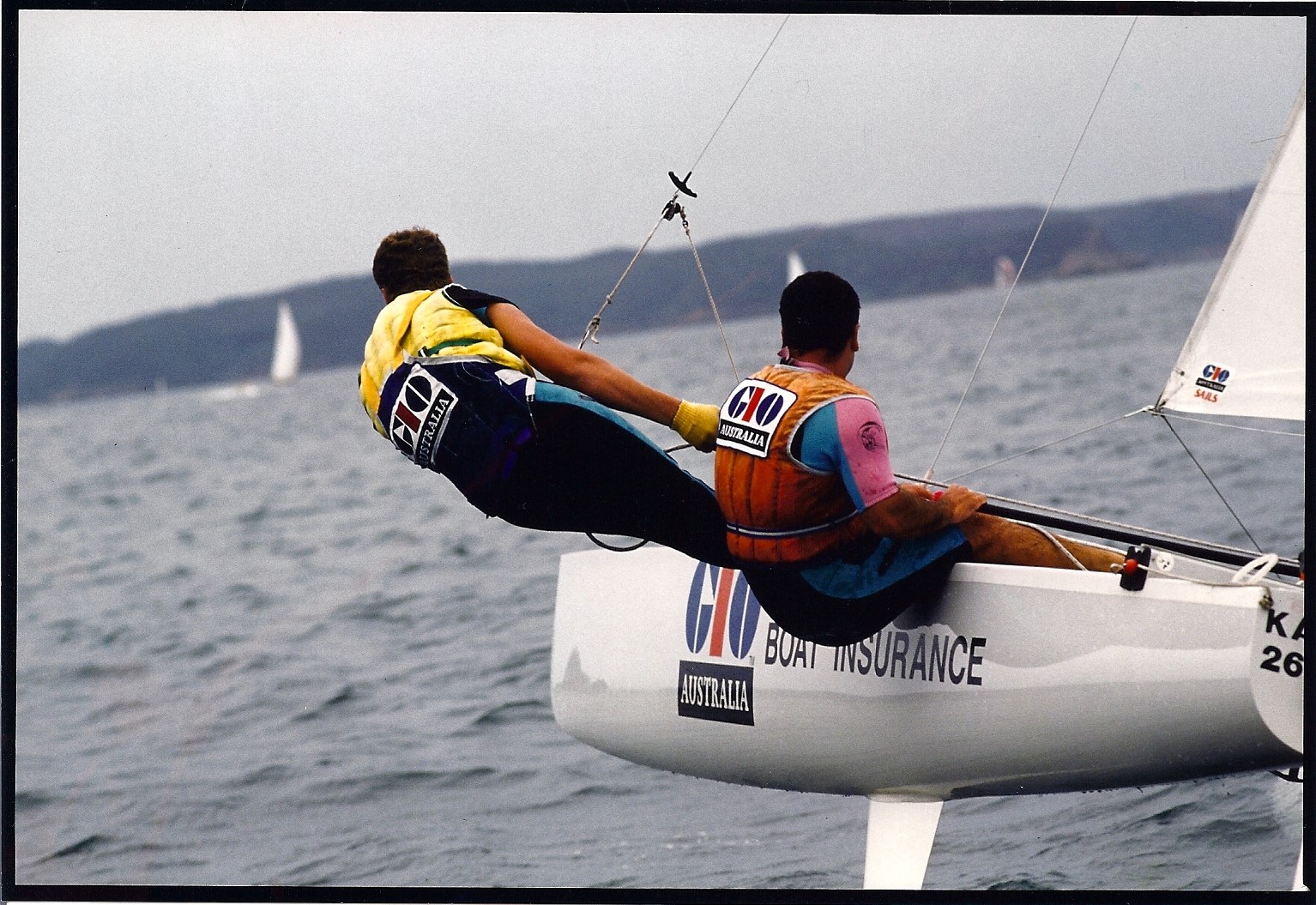
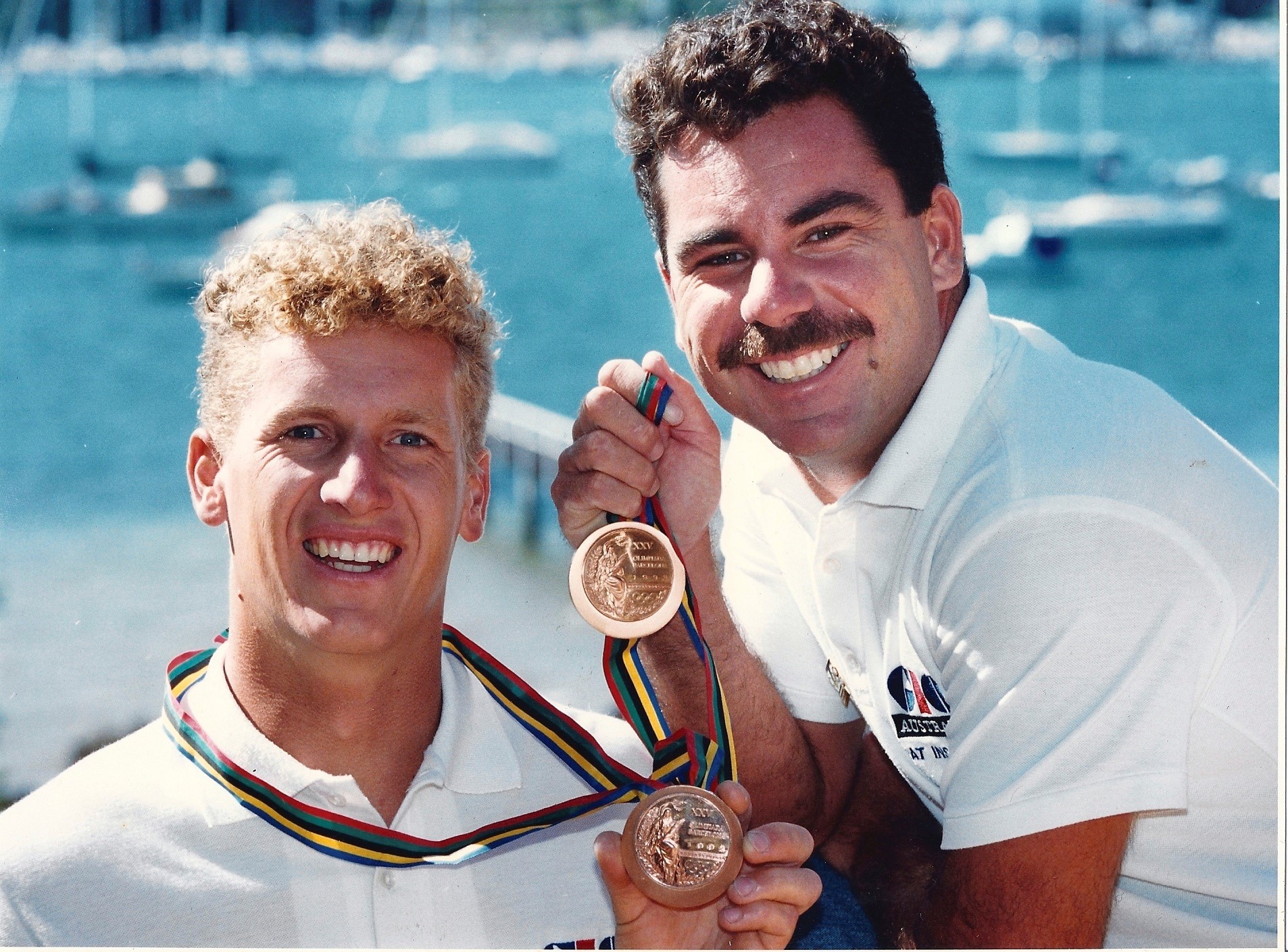
John Forbes and Mitch Booth - Barcelona Olympics - photos courtesy J Forbes.
What happened between Barcelona and the Sydney 2000 Olympics?
I kept sailing. We did try out for the 1996 Olympics. We had done very well, I ended up sailing with new guy Darren Bundock, another great sailor. Darren and I ended up sailing together for 10 years.
That was our first Olympic campaign together but the Yachting Federation didn’t choose us.
That was also a bit of a revolutionary time as, while we had technically won the selection criteria according to the letter of the law, the Yachting Federation said ‘that’s fine, but we actually want to send Mitch because we think he’s going to better in six months time’.
We pointed out that that wasn’t what their selection criteria was, and there was a legal stoush relating to that and it ended up in court where the court said ‘that’s fine if you don’t want to stick to your selection criteria, you can send Mitch. But, these guys have all outlaid money to compete to comply with the selection criteria so you will need to refund them all that money.’
Refunding everyone’s costs just about sent the Yachting Federation bankrupt, to the point where they could not pay us the money. Once again they did not recognise the crew at the same value as the skipper, and because of that were giving out random points to the crews that had split from their skippers. So it was quite hectic.
The outcome of that was that the Australian Olympic Committee got heavily involved in writing the selection criteria for the 2000 Olympics. They used that Australian sailing case as a clear indication of what not to do, and especially being a home Olympics, they wanted it to be controversial free. So for the 2000 Olympics they used such and such events but ultimately the selection was still at the discretion of the yachting committee – so they were still saying ‘you can win all those events but they still reserve the right to send whoever they want’. That was a really tough time for us.
Fortunately Darren and I were very competitive at that time and no one could get anywhere near us. We won the 1998 World Championship, we won a couple of European Championships and three or four more Australian Championships. We won both the Olympic test events in 1998 and 1999 and would appear to have been a shoe-in for us, so much so that Mitch went to compete for Holland after that as he still wanted to go to the Olympics, just not for Australia.
The home Olympics was off the chart in terms of the overall sporting event but again we had light winds for the first week of the sailing which was not what we ordered. The races where it did blow above 5 knots we either got 1st or 2nd and we ended up winning the Silver medal with a day to spare. The Gold medallist, Roman Hagara, the guy from 1987, he and his crew were extremely light. Between 1987 and 2000 they had hardly won anything because they were too light. But during the Sydney Olympics we had very light wind, perfect conditions for them, and they got the Gold medal. Whilst it was exciting to win the Silver medal at home it was a shame it didn’t blow. The second week of the Olympics it did blow, so much so that it was blowing the rowing boats off the course at Penrith, but that’s just Mother Nature and part of the core of the sport.
Darren and I then continued on and won the next three World Championships, bringing my tally up to six World Championships in an Olympic class catamaran. There are a lot of highlights among all of that. In 1998 when I won the first World Championship with Darren that was actually my third World Championship and also made me the first person in history to win three World Championships in the Tornado class. Eight other teams had won it twice since the boat was built in 1969 but getting that third one was pretty special. A lot of old-timers in the class said to me ‘you’ve finally done it, someone has finally broken the voodoo’.
You then went on to win seven World Championships all up though?
Yes (laughs). Trying to win the third one took a long time but after that the good run continued.
The Athens Olympics of 2004 – how was that?
This was again a very light air regatta and again the Austrians won.
Are you good mates with Roman?
Yes, we are good mates, there was never any problem there.
In 2001, 2002 and 2003 we won the European Championship and the World Championship – we were also winning many other major events on the way to the 2004 Olympics and were ranked Number 1 in the world for two or three years, so we were hot favourites. Then it just didn’t blow – we were sailing upwind with the spinnakers up, then downwind without the spinnakers – I think we only had two days where it blew above 4 knots. We came away placing 6th in that event. So whilst it was awesome to compete in that Olympic event and we did very well leading up to the event, it could have been disappointing but to be honest, I’m not disappointed about any of it. I appreciated the experience and it’s not just that one week of the Olympics, it’s the four years or eight years leading into it and all you do prior as much as that event.
When I planned to stop sailing Darren wanted to keep going. We spent three years preparing for that. I said in 2001 I was going to stop after Athens in 2004. Prior to that time I was looking after the sponsors and dealing with the federation – Darren was busy working as much as sailing. We did a three year transition where I stepped back and he stepped forward so that after 2004 Darren was dealing with the team and all that went with it. We did the same with all the assets – the boats, trailers, we made sure that was all in Darren’s possession by the end of it. He continued on, went to Beijing and got a Silver medal with Glenn Ashby and both of them went on from there to be in the America’s Cup in San Francisco – Darren was on the US team, Glenn was on the New Zealand team. So it was awesome to see Darren and Glenn go on and get that medal and to see what I’d started get carried through. We’re still good mates, still keep in contact, and that’s what makes sailing so great too – we could all team up again tomorrow and go sailing; it’s ageless and timeless, one of the few sports that is.
You then got out of sailing in 2005 to spend time with your young family and ‘sell dairy products’?
That has been our family business for 42 years and is still around today – MPD Dairy Products. We’re based up at Belrose and we’re a major supplier to food manufacturers. So anyone who is making chocolate, yoghurt, bakery goods, flavours, sports nutrition or who needs any sort of food ingredient, like butter, milk powder, cheese, cream, we supply it.
Do you get all your raw product from Australian producers?
As much as we can. Australia is really struggling at present with dairy – butter prices have gone through the roof and we’re bringing a lot in from New Zealand as we just can’t get enough here and can’t meet demand – the amount of milk being produced in Australia is just not enough.
We’re getting constant reports of how Australian Dairy Farmers are going down the gurgler due to low prices fixed for their products. Have you had any contact with that?
It’s a horrible situation at present. Some of the biggest dairy companies have been poorly managed at times, and that hasn’t helped the farmers. A lot of people want the government to step in but it’s not a government issue, it’s just some dairy co-operatives have been poorly managed. There are some dairies who are managing what’s happening very well. Sure the environment is a part of the issue, not having enough water, but a lot of it does result from just bad management.
So Bronte, one of your daughters, will be sailing with you in the PBSC Beware the Bullets regatta for 2018?
Yes. I have another daughter Teigan, who doesn’t sail regularly but did sail with me last year as Bronte was busy one weekend, and that happened to be the weekend that Teigan and I won the NSW State Titles. So Teigan has basically sailed one weekend and is now a State Champion, whereas Bronte has sailed for two years and is not a State Champion – so that was funny for us all.
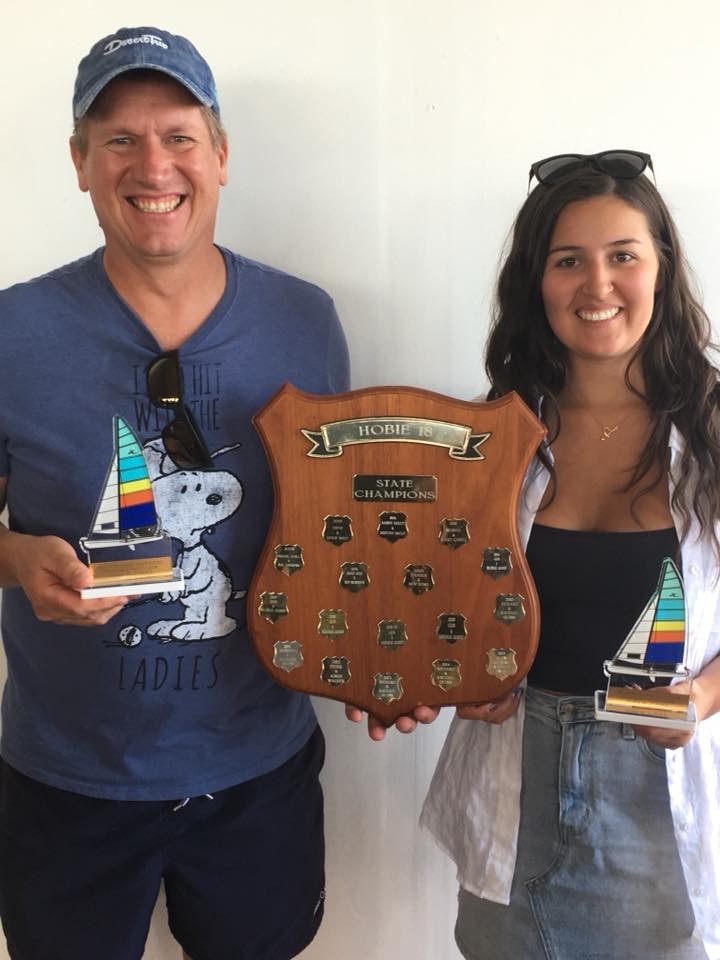
Teigan and John Forbes - State Champions
Teigan was born in 1998 when I were still in competitive Olympic sailing and Bronte was born in 2001 so we started taking the girls overseas a lot while I was still competing. Teigan came overseas when she was 11 days old and we went through Europe for three months. My parents didn’t see her for the first three months. Then Bronte was born so both the girls have been around sailing since day one. Teigan experienced the Sydney Olympics at age 3, so that was quite exciting for her, not that she can remember too much. Then Bronte was 3 when she went to the Athens Olympics and again, she can’t remember much, but she was there. They remember the people and the names as we were sailing against a lot of the same people over and over.
Taking two girls around Europe for three months is quite a task though; you have to keep them amused for months. In our trailer we had two catamarans but we also had car baby seats, nappies, inflatable kiddie swimming pools, bikes, cots – we had more baby stuff then we had sailing stuff. So it was quite a big task to cart the girls all around Europe and USA as well as doing an Olympic campaign. I had decided quite early that I was going to stop after Athens and concentrate on family and being at home. The dairy business was growing as well and there was a lot of pressure on the staff to fill in when I was away, so I decided I would stop after Athens. The girls needed to get settled into school rather than being shipped from hotel to hotel. I also had a lot of people saying to me, ‘you have to be careful John, they’ll be 16 and moving out if you blink and you don’t want to miss it’. So we knew we’d be stopping. You also have to remember that sailing is an ageless sport and I knew that even if I stopped after Athens that I could potentially get back into it 10 or 15 years later. There was one guy at the Athens Olympics, a very good friend of mine, Christos Garefis, the oldest member of the Greek Olympic team at 49 years of age, still sailing the Tornado catamaran, and doing it as though he was still a 19 year old, and so I took a lot of respect out of that and also just thought that I could certainly start sailing again when the girls had grown up – I didn’t want to miss seeing them grow up. And so 10 or 11 years later we got back into it and now I’m having fun with my daughter.
Many of the sailors you have spoken of all have an association with sailing on Pittwater. What do you think it is about Pittwater that produces so many World Champion elite sailors?
Certainly the area is popular for sailing, you can actually do sailing as a sport at school, and there is certainly potential to expand that. Having everyone living near the water, whether it’s for the surf or on the estuary, also contributes – so some kids just grow up with this naturally in their system. But Pittwater is also a very hard place to sail because of the hills all around it and the different bays, estuaries or river that comes off it. That creates wind tunnels and lifts and knocks – the conditions can be very tricky. Our club’s motto is ‘If you can sail here, you can sail anywhere’.
A lot of people say that it is a very tough place to sail, and setting a course is not easy as the wind only needs to change 5 degrees and that actually means the wind is coming out of a completely different bay and you then have to set a completely different course to make it around. So it’s that side of it, for sure.
Who taught you to sail in such conditions?
My dad. I was different in that I didn’t do any junior program. No Tackers, no BYRA or Avalon or RPAYC, nothing like that. I never sailed a monohull and in nearly all of those junior programs you learn in a monohull, I skipped that completely. A lot of those kids start when they’re 8, 9, 10 years old – I didn’t do any of that. I went straight into catamarans at 11 and 12 years of age, so I don’t really know that much about that process. But it is a good process and many people come through that system and excel, but that wasn’t what I did.
Did your grandfather sail?
No.
So it’s just the three generations?
Yes.
How we actually got into sailing originally was, my father used to do motor racing at Bathurst. In the mid 1970’s he was racing a lot at Bathurst, and did this from 1969 until 1982. One of his good friends at that time, who still is today, is Colin Bond, who is quite famous for his racing at Bathurst.
Colin Bond actually had a Hobie 16 and he introduced my father to this. He invited us away camping one weekend when I was about 5 and Colin took his Hobie 16 with him and took my father sailing with him and from that day on my father was hooked.
So I never mentioned this to Colin but he is probably responsible for my getting into sailing and all that came afterwards.
Your dad sounds like a bit of a legend.
My dad is indeed a legend.
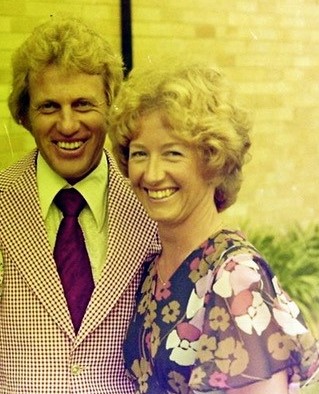
Bob and Joyce Forbes - 1970's
These two particular cars are currently at Balgowlah Automotive because the business owners father was the mechanic for my father when these cars were originally built. The car in the background, the 1972 Torana, the co-driver for that year was Dick Johnson.
Who is this Bartlett – is that?
Yes, Kevin Bartlett. Who was also a co-driver for my father for many years. We no longer know where the original cars are so the guys at Balgowlah Automotive built two replicas that are spot on – you can’t tell the difference.
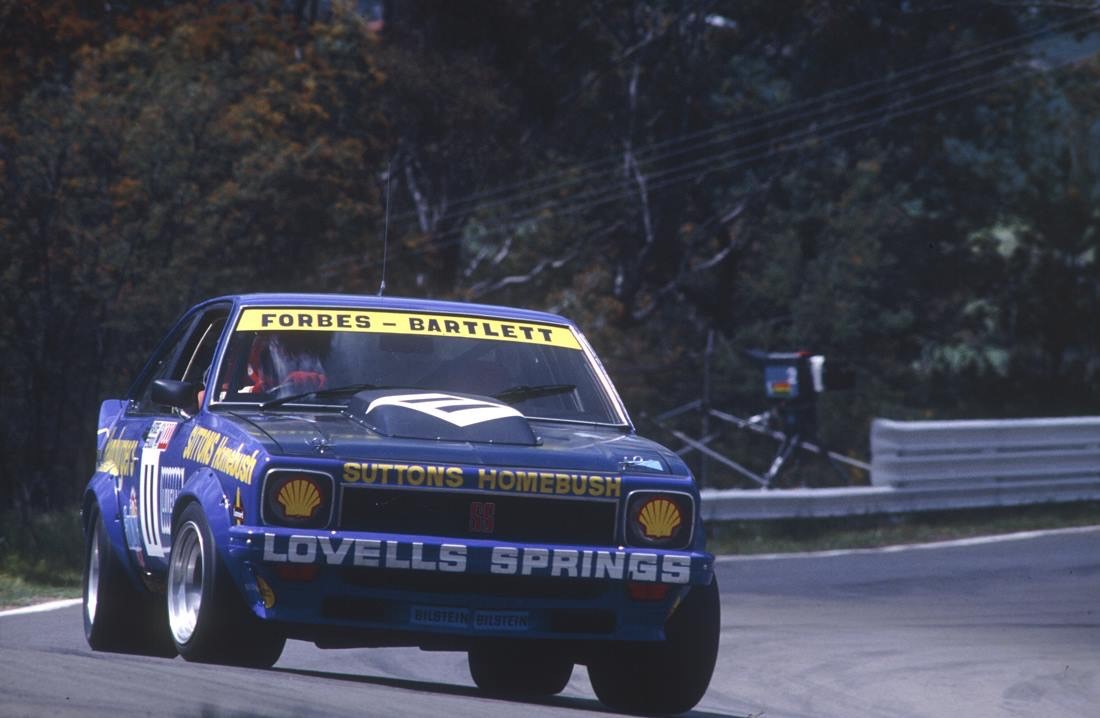
A Forbes - Bartlett car
This is dad on the front cover of Sea Spray magazine.
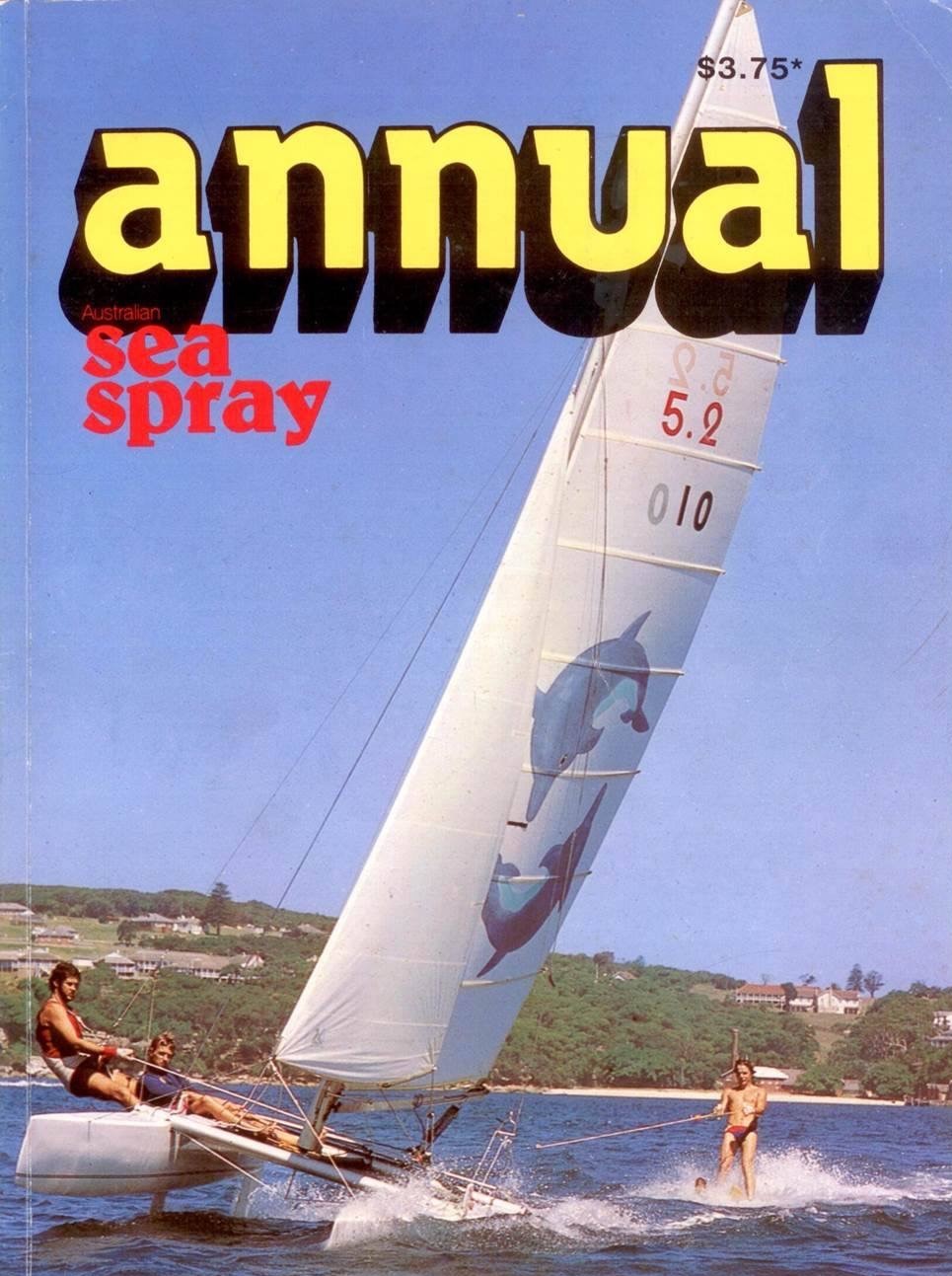
Sea Spray cover - Bob Forbes
Who is teaching Bronte and Teigan then?
Me.
The second aspect of why so many great sailors come out of this area has to do with our club too. If you take a look at the Palm Beach Sailing Club, which was once also known as the Pittwater Catamaran Club, we had Ian Bashford, Chris Cairns, Mitch Booth, Rod Waterhouse, the next generation in the Darmanin family and Rod’s son Jason, a lot of them have been through the club at some stage. It’s a very small club membership wise, very casual, off the beach sailing – but they all do really, really well.
For a lot of the time I was sailing there during the 1970’s and 1980s and even the early 1990’s through those massive regattas and when we had the Nacras, there would often be between 100 and 300 catamarans on the beach up at Governor Phillip Park. Pittwater Catamaran Club even then was still just an esky in the back of Mike’s white commodore over there. There was no clubhouse, no formal yacht club proceedings, no hardstand, no ramp – none of that stuff, just ‘who has got the esky this week?’ and a focus on sailing, on enjoying it. It was very casual, very low key – there were and are some great clubs around, but you had to wear a collared shirt and polished shoes and pucker up while they fire off the canon, and that wasn’t what we did and I think that was unique.
That same culture exists today; it’s casual, friendly and relaxed – until we all get out in those Pittwater breezes and let rip. As a result of that there’s very low overheads and there’s not much to worry about outside of maintaining the rescue boat or buying a few buoys.
So the Beware the Bullets Regatta this year – what’s incorporated into this for 2018?
The regatta this year will also be the State Titles for the Taipan class. The Taipan is an Australian designed catamaran and very light, very fast, often sailed by husband and wives teams or father and kids. The Taipan isn’t normally sailed on Pittwater so it will be a good opportunity for those not familiar with the boat to see what they’re all about – it would be great to see this class of boat sailing regularly on the estuary.
The club has been traditionally a Hobie focused club so we’re trying to bring in all those other classes – we already have had Wettas there for a few seasons now and would like the more traditional catamarans sailors to try out some of these other classes. We now have some Viper boats with the spinnaker, as well as some of the more recent Nacras. Again there will be some Hobie 18’s competing, whereas traditionally the club has been a Hobie 16 club. So there will be quite a mixed fleet this year.
So you are sailing with your daughter Bronte – how many races do you expect to win, Olympian?
(Laughs)
We have this thing where Bronte and I have a lot of second places. My wife Caroline gives me a lot of stick about that. The Bullets Regatta for us is two weeks before the State Titles so it’s a good lead in for that. Naturally we would like to win every regatta but sailing is sailing and the wind doesn’t always turn up for that. We are not necessarily out there to win – we’re out there to have fun. For me it’s very much a father-daughter time. I just happen to be able to sail, and when I go sailing can do it with my eyes closed and therefore can enjoy my time with Bronte. If we didn’t sail we may do something else, shopping for example, but for me this is a really good thing we can do together to bond together a lot more. That’s what it’s about for me. If we win it’s a bonus – but Bronte doesn’t have this strong desire of ‘we have to win’ – she too is taking it as an opportunity to have good fun and learn more about the sport – so we’ve won anyway really. In fact Bronte has said ‘we win either way’.
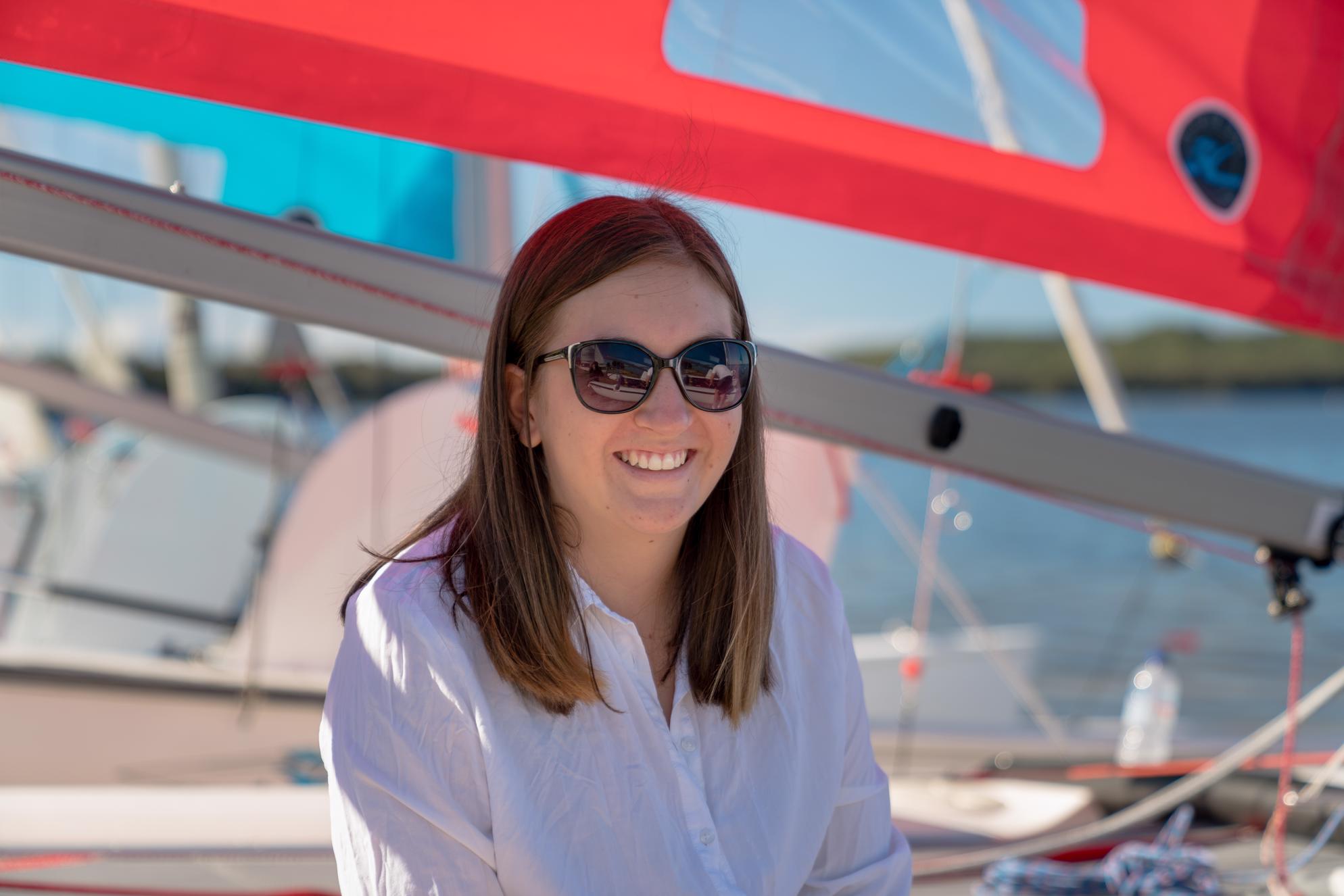
Bronte Forbes
What would you say would be the key to your success?
I can’t really answer that question as it is something that is unique to every person. What was successful for me may not work for the next person. We did certain things that made us relaxed prior to competing and I think that in itself contributed to our results.
Throughout it all we treated sailing at that elite level as a privilege. It wasn’t a job for us – we were really looking forward to going overseas to go sailing. I travelled the world for 18 years and went to many different countries. Every time we went we looked forward to going and never took it for granted. We were there to compete and alike our German and Greek friends we realised where we were and didn’t miss any opportunity to see what was special about each place.
I think making sure we did experience any place was part of that journey. If another sailor since then was travelling to say, Palma in Mallorca, I’d say, ‘the day before the regatta go up to Formentor; it’s a beautiful outlook, the equivalent of going to Barrenjoey lighthouse – go up there, get out of the club and then come back and you’ll be ready to go’.
A lot of people miss that side of things, and that opportunity to become relaxed prior to competing.
Also keeping focused on meeting great people was a key too. The German guys stayed with us for months when they were in Sydney. One guy even came out and did an apprenticeship in Sydney and lived with us while doing so.
We sailed, trained and lived with the German guys from 1992 through to 2004 – we’re mates for life – they still contact me regularly.
What are your favourite places in Pittwater and why?
I don’t have any particular spot, but certainly the sailing up in the northern end of the estuary, from Careel Bay north up to under Barrenjoey is one of the best flat-water sailing places that I know of. That is because the water is clean, the waterways are clear, there’s very few powerboats and no big ferries or shipping and very few moorings in that area. That’s what makes it good.
It has a little bit of tide, the wind can come from the south or north-east. So all that makes it an excellent area.
Having said that, outside, between Barrenjoey, Lion Island and Ettalong, is awesome.
We did a lot of training out there before the Sydney Olympics. We had the German team and the Austrian team training with us on Pittwater. We would all sail in that outside place for weeks as it was one of the best places to do what we call speed training.
And then for the 2000 Olympic Games we got no wind, so it was all a waste.
Still, it was excellent – much better than sailing on the harbour. Whilst we sailed the Olympic races on the harbour and outside the harbour that was ok because they banned all boats being on the harbour – but trying to train on Sydney harbour in the lead up was just impossible and not beneficial. Those that did had a hard time with no good results whereas those that trained up here, out of Pittwater, did well – in fact that was the Gold, Silver and Bronze in one.
I don’t have a lot of love for sailing at the southern end of Pittwater anymore, simply because there are too many moorings going too far out – I think they need to stop letting people encroach on the open water. But certainly up the top end there’s still some great courses you can set and sail.
What is your ‘motto for life’ or a favourite phrase that you try to live by?
I’m loving it.
Not too many things phase me.
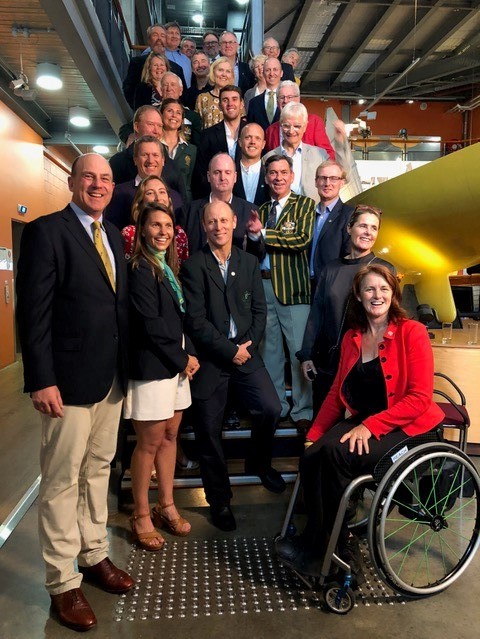
John at Barranjoey Pin presentations and launch - 2018
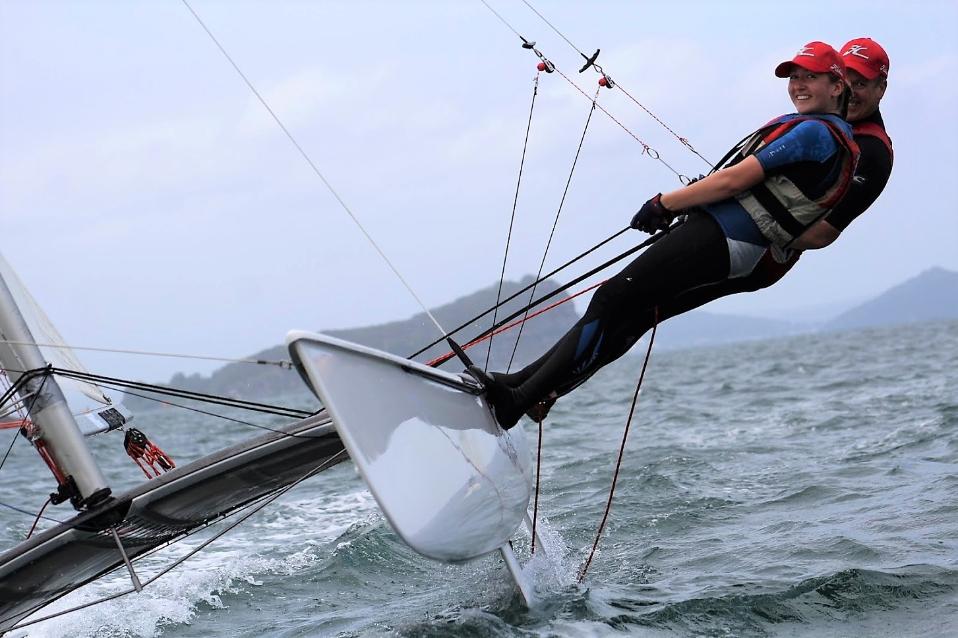
Forbes Family during the PBSC Beware the Bullets Regatta 2016
John Forbes was introduced to catamaran sailing on an international level at the age of 12. He and father Bob went to the USA to compete in the 1982 Nacra 5.2 North American Championships where they placed fourth. The following year John and Bob attended the inaugural Nacra 5.2 World Championship where they came second, and John then travelled to Monterey Bay where, with fellow Australian David Renouf, they finished 4th place in the Nacra 5.8 North American Championship.
After this "deep-end dunking" as a crew John took over the helm of various types of catamarans and with brother Rod on a Nacra 5.2 won the 1985 Australian Combined High Schools Championship outright, winning a couple of the races in the series on handicap/yardstick as well as outright. John, with Rod as crew, also came 3rd in the 1985 Nacra NSW State Championship, 1st in the 1986 Nacra NSW State Championship, 2nd in the Prindle 18 National Championship and 4th in the Nacra Australian Championship.
John's first introduction to the International Tornado Class was at the 1986/87 Australian Championship in Perth where, whilst only 16 he helmed his first Tornado catamaran and placed 10th amongst a star-studded fleet including Multi Olympic Gold Medallist Poul Elvstrom, “the Great Dane”.
John's youthful success and versatility, together with his accumulated competitive experience on different sized catamarans, resulted in him being approached by 1984 Olympic Bronze Medallist Chris Cairns, who asked John to sail with him. Together they won the 1987 Kiel Week Regatta followed by a second place in the 1987 Tornado Class World Championship.
In 1989 John teamed up with Hobie legend Rod Waterhouse to win the Australian Tornado Championship with a perfect score winning all 8 heats. Rod Waterhouse's inability to travel overseas in 1989 led John to join up with longtime sailing rival Mitch Booth, and together they won the 1989 World Championship (Houston, Texas) by an astounding 36 points from their good friend Giorgio Zuccoli from Italy. They also won the 1990 and 1991 Australian Tornado Championships.
A role reversal in 1991 saw John again taking over the helm to win the inaugural Nacra 5.8 World Championship (Hervey Bay, Queensland). Mitch and John's credits also include winning the `92, `93 & `94 Tornado Australian Championships and in 1992 they won their second Tornado World Championship (Perth, Australia).
Gold and Silver medals were also won in the 1990 and 1991 Barcelona Pre-Olympic Games respectively, and the pair were rewarded when they won a Bronze Medal at the 1992 Barcelona Olympic Games. As a result, they were jointly awarded the prestigious New South Wales Yachtsman of the Year trophy in November 1991 and again in 1992. As a final toast they were honoured, again jointly, with the distinguished award - as 1992 Ampol Australian Yachtsman of the Year.
A creditable second place was scored at the 1993 Tornado World Championship (Long Beach, USA) and was followed up by a third place at the 1994 World Championship (Bastard, Sweden).
A twelve-year relationship with the Tornado Class has also seen John give back an enormous amount of personal time and effort to both the Australian International Tornado Association (AITA) and the International Tornado Association (ITA). He was elected President of the AITA in 1994 taking over the reins from Dr Peter Blaxland who had been President for the past 20 years. John's significant contributions to the Class both nationally and internationally led him to be re-elected again in 1996. At the ITA AGM in Canada in August, 1995 John was also elected as President of the ITA in charge of International and Olympic affairs and was also responsible for the election of the new younger and pro-active Technical Committee of the ITA.
January 1995 saw a major change to John's Olympic Tornado Campaign with the much publicised break-up with partner Mitch Booth.
John teamed up with his main competitor and longtime catamaran sailor Darren Bundock who had impressed Forbes during his 1992 Olympic Games Campaign. Together they established a successful two-boat training campaign as part of their lead-up to the 1996 Selection Regattas.
Their successes stream-rolled by winning both the Sail Sydney Regatta and the NSW State Titles. An outstanding result at the Pre-Olympic Regatta in Atlanta saw the pair place 4th. One week later they followed up at the 1995 Worlds in Kingston, Canada with a final placing of 14th (8th Nation). Not bad considering on the second day of racing they were cut in half by an Austrian Team and were forced to miss both heats 2 & 3 of the series as their hull was beyond repair.
January 1996 saw Forbes and Bundock win the Australian Championship by a clear 10 points from a star-studded International fleet in preparation for the 1996 World Championships. At the 1996 World Championship (Mooloolaba, Australia), Forbes and Bundock finished a brilliant third overall.
With the Olympic Selections up for grabs these two sailors believed they had proven beyond doubt that they were at the elite level required to bring home a Gold Medal from Atlanta. However, as a result of the Australian Yachting Federation changing the AOC endorsed Olympic Selection Criteria after the first of the two Olympic Selection Regattas had been completed, John and Darren were denied selection to the Australian Olympic Team and forced to set their sights on Sydney 2000. Determined by the disappointment of denial of Olympic Selection, John and Darren kept the momentum of their Olympic campaign with training partner Andrew Macpherson. John and Darren dominated the Australian Tornado Regatta circuit and won the 1996 NSW and QLD State Championships.
1997 saw John and Darren top the Australian Yachting circuit by defending their National title crown in Perth, winning the International Sail Melbourne, Go for Gold regatta and placing second in the Sail Sydney regatta. John and Darren placed best Australian in both the 1997 NSW State Titles (3rd overall) and the Australian International Regatta, Sydney (2nd overall), a 5th place (3rd Nation) at the 1997 World Championship in Bermuda and then topped off the year by winning the 1997 Sydney International Regatta.
1998 started off with John and Darren winning their third Australian Championship in a row. In May and June they went off to Europe to place third at both the European Championships in Greece and the Kiel Week event in Germany as well as winning the Danish Spring Cup and placing the best Australian in the Dutch Spa Regatta.
In September, John and Darren sailed away with the GOLD at the Sydney Harbour Regatta, organized by SOCOG as the first ever Sydney 2000 Olympic Test event.
In November John and Darren achieved their greatest feat to date winning both the South American Championship and the 1998 World Championship (Buzios, Brazil). They never looked back, winning the World Championship by an incredible 18 points from longtime training partners Roland Gaebler and Rene Schwall (Germany). This win made John the first ever Tornado sailor to win three world championships. Since 1967 there were eight sailors who had previously won two world championships but 31 years after the inaugural event Forbes became the first person to make it three wins.
John and Darren started off 1999 the way they left 1998 by winning Sail Melbourne which was represented by six nations. February saw the pair cross the Tasman to dominate the Sail Auckland regatta.
By the end of 1999 they had finished a four-month European campaign and captured the Number 1 spot on the prestigious ISAF O’Neill World Rankings after winning the Princess Sofia Trophy (Spain), the European Championship (Spain), Kiel Week (Germany) and placing 3rd in Hyeres and 4th at the World Championships in Copenhagen, Denmark. By the end of January 2000 they were selected into the Olympic Team to represent Australia in their hometown Sydney 2000 Olympic Games where they won the Silver medal. The Gold medal was won by Roman Hagara and Hans Peter Steinacher from Austria with it being Austria's first ever Gold medal at the summer Olympics.
Their achievements after Sydney 2000 continued with Bundock and Forbes clean streaking the 2001 Tornado regatta program by winning the World Championship in Richards Bay, South Africa in February and their second European Championship in Silvaplana, Switzerland in August. They also won the 2001/02 Australian Championship for the fourth time together (Forbes’ 10th time) and the 2002 NSW State Titles.
Awards and rewards
On 11 December 2001 Darren and John were one of five finalists for the NSW Institute of Sports “Athlete of the Year”. Other finalists included (first ever female) World Rowing Champions Vicky Roberts and Julia Wilson, Triathlete Peter Robertson, Louise Savage from wheelchair track and road and swimmer (and winner) Ian Thorpe. On 17 December 2001 John was inducted into the Sydney Northern Beaches Hall of Fame alongside other famous sporting personalities including surfing’s Tom Carrol, Netball’s Anne Sargeant and Swimming’s John Devitt. On 27 February 2002 Darren and John were awarded the Australian Institute of Sport top “Athlete/Team of the Year”. This was then followed by Darren and John being awarded the “2001/02 BEA Australian Sailor of the Year” award at Darling Harbour on 8 June 2002. Darren & John were ecstatic with this announcement having previously been finalist in 1999 and 2000 and it being ten years since John previously won the award after his 1992 World Championship and 1992 Barcelona Bronze Medal haul.
Darren and John continued their success in 2003 winning the three biggest and most important Tornado Regattas of the year being the 2003 European Championship (Gran Canaries), the 2003 Athens Test Event (Pre-Olympics) and the 2003 World Championship (Cadiz, Spain - 72 boats from 26 nations). The win for Darren and John put them again in the record books as it was John’s incredible sixth Tornado World Championship Title (1989,92,98,01,02,03) and Darren’s fourth (98,01,02,03). Forbes equalled that of Brazilian sailor Robert Schiedt who had recently won six Laser dinghy class World Titles. Combine all of that with winning the 2003 Sail Melbourne regatta in January and the pair were selected to represent Australia at the Athens 2004 Olympic Games and were earmarked by many as being the Gold medal favourites.
As a result of the successes both in 2002 and 2003 Darren and John also received the following accolades: Australian Institute of Sport – Team of the Year. Australian Yachting Federation – Male Sailors of the Year. NSW Yachting Association – Male Sailors of the Year. NSW Institute of Sport – Team Athletes of the Year. International Sailing Federation – Rolex World Sailor of the Year - finalist.
Whilst the Greek wind Gods didn't show up on time for the Tornado event in Athens, John and Darren still finished a credible 6th place overall and, after three Olympic Games and 18 years at World and Olympic level sailing, Forbes announced his retirement from the sport due to family commitments with his wife Caroline and two daughters Teigan and Bronte. Darren Bundock continued sailing Tornado catamarans and, with Glenn Ashby as Forbes' replacement, they went on to win a further world championship and the Silver medal at the Beijing 2008 Olympic Games. Both Darren and Glenn then joined the highly spectacular and successful 2013 America's Cup teams.
Reference - AIS at the Olympics Archived 9 February 2012